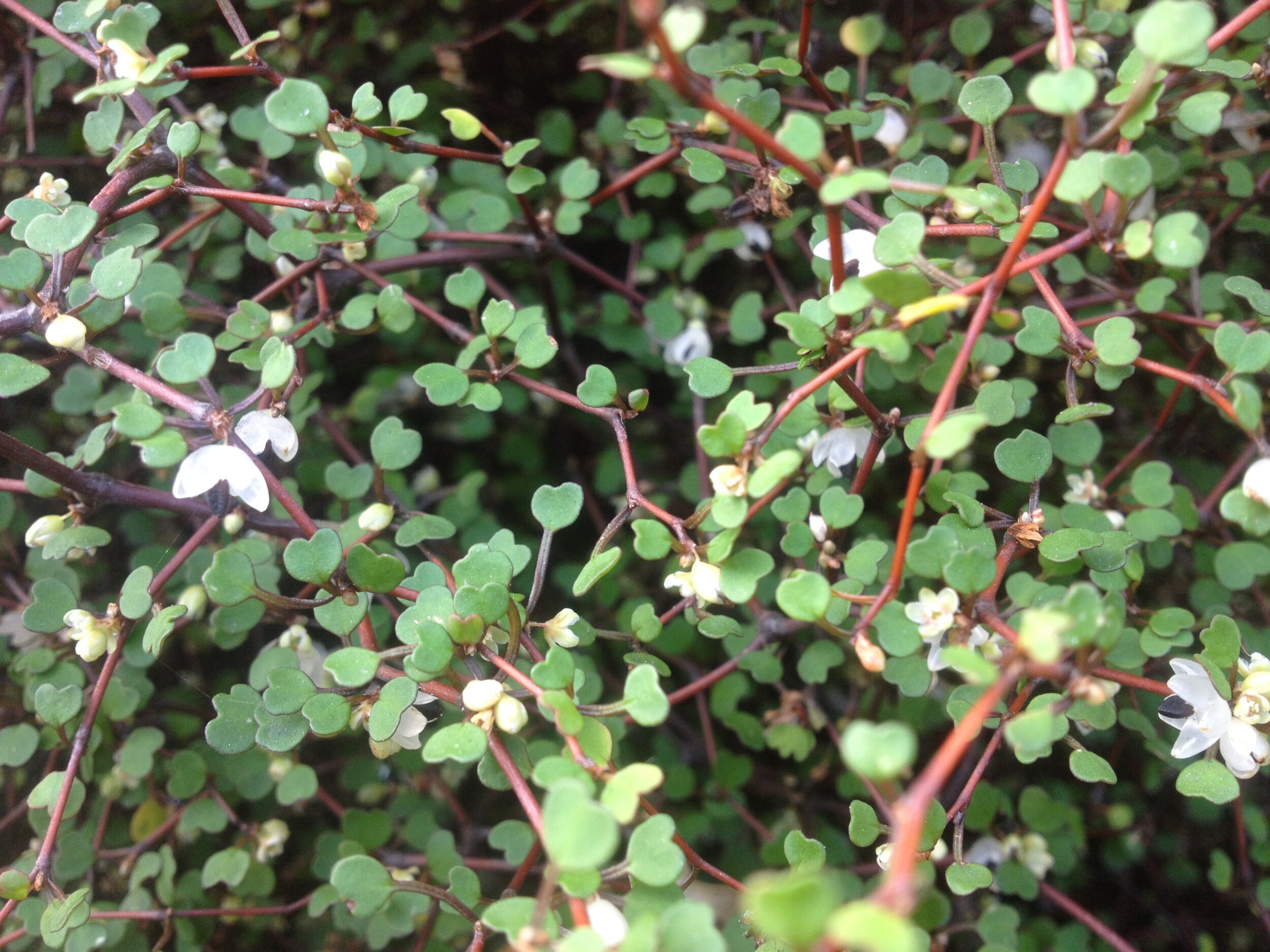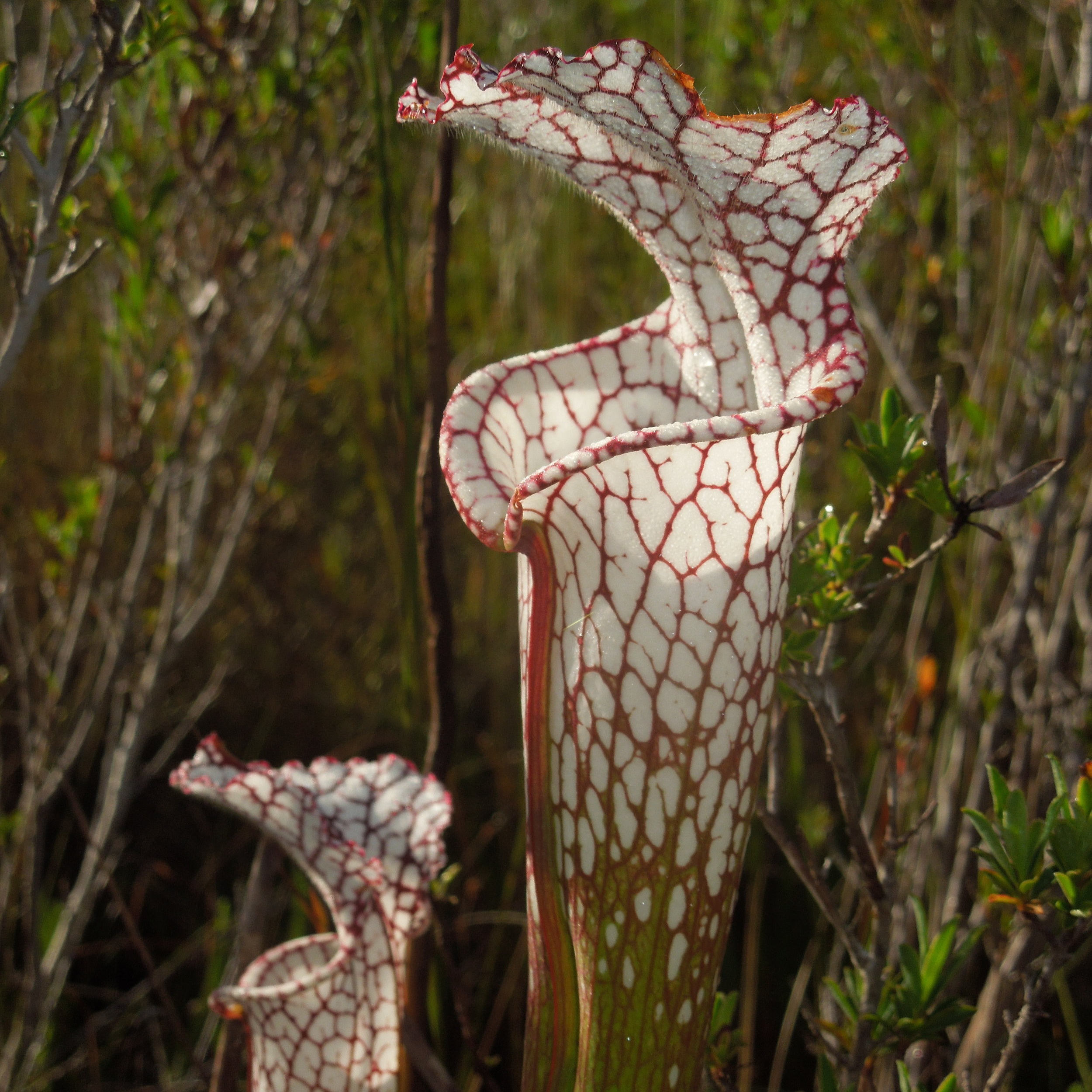Photo by Jon Sullivan licensed under CC BY-NC 2.0
I was watching a gardening show hosted by one of my favorite gardeners, Carol Klein, when she introduced viewers to a beautiful, divaricating shrub whose branching structure looked like a dense tracery of orange twigs. She referred to the shrub as a wiggy wig and remarked on its beauty and form before moving on to another wonderful plant. I was taken aback by the structure of the shrub and had to learn more. Certainly its form had to be the result of delicate pruning and selective breeding. Imagine my surprise when I found its growth habit was inherent to this wonderful and rare species.
The wiggy wig or shrubby tororaro is known to science as Muehlenbeckia astonii. It is a member of the buckwheat family (Polygonaceae) endemic to grey scrub habitats of eastern New Zealand. Though this species is widely cultivated for its unique appearance, the shrubby tororaro is not faring well in the wild. For reasons I will cover in a bit, this unique shrub is considered endangered. To understand some of these threats as well as what it will take to bring it back from the brink, we must first take a closer look at its ecology.
Photo by WJV&DB licensed under CC BY-SA 3.0
As mentioned, the shrubby tororaro is endemic to grey scrub habitats of eastern New Zealand. It is a long lived species, with individuals living upwards of 80 years inder the right conditions. Because its habitat is rather dry, the shrubby tororaro grows a deep taproot that allows it to access water deep within the soil. That is not to say that it doesn’t have to worry about drought. Indeed, the shrubby tororaro also has a deciduous habit, dropping most if not all of its tiny, heart-shaped leaves when conditions become too dry. During the wetter winter months, its divaricating twigs become bathed in tiny, cream colored flowers that are very reminiscent of the buckwheat family. From a reproductive standpoint, its flowers are quite interesting.
The shrubby tororaro is gynodioecious, which means individual shrubs produce either only female flowers or what is referred to as ‘inconstant male flowers.’ Essentially what this means is that certain individuals will produce some perfect flowers that have functional male and female parts. This reproductive strategy is thought to increase the chances of cross pollination among unrelated individuals when populations are large enough. Following successful pollination, the remaining tepals begin to swell and surround the hard nut at the center, forming a lovely translucent fruit-like structure that entices dispersal by birds. As interesting and effective as this reproductive strategy can be in healthy populations, the shrubby tororaro’s gynodioecious habit starts to break down as its numbers decrease in the wild.
Photo by Jon Sullivan licensed under CC BY-NC 2.0
As New Zealand was colonized, lowland habitats like the grey scrub were among the first to be converted to agriculture and that trend has not stopped. What grey scrub habitat remains today is highly degraded by intense grazing and invasive species. Habitat loss has been disastrous for the shrubby tororaro and its neighbors. Though this shrub was likely never common, today only a few widely scattered populations remain and most of these are located on private property, which make regular monitoring and protection difficult.
Observations made within remnant populations indicate that very little reproduction occurs anymore. Either populations are comprised of entirely female individuals or the few inconstant males that are produced are too widely spaced for pollination to occur. Even when a crop of viable seeds are produced, seedlings rarely find the proper conditions needed to germinate and grow. Invasive grasses and other plants shade them out and invasive insects and rodents consume the few that manage to make it to the seedling stage. Without intervention, this species will likely go extinct in the wild in the coming decades.
Photo by John Pons licensed under CC BY-SA 4.0
Luckily, conservation measures are well underway and they involve cultivation by scientists and gardeners alike. There is a reason this shrub has become very popular among gardeners - it is relatively easy to grow and propagate. From hardwood cuttings taken in winter, the shrubby tororaro will readily root and grow into a clone of the parent plant. Not only has this aided in spreading the plant among gardeners, it has also allowed conservationists to preserve and bolster much of the genetic diversity within remaining wild populations. By cloning, growing, and distributing individuals among various living collections, conservationists have at least safeguarded many of the remaining individuals.
Moreover, cultivation on this scale means dwindling wild populations can be supplemented with unrelated individuals that produce both kinds of flowers. By increasing the numbers within each population, conservationists are also decreasing the distances between female and inconstant male individuals, which means more chances for pollination and seed production. Though by no means out of the proverbial woods yet, the shrubby tororaro’s future in the wild is looking a bit brighter.
This is good news for biodiversity of the region as well. After all, the shrubby tororaro does not exist in a vacuum. Numerous other organisms rely on this shrub for their survival. Birds feed heavily on its fruits and disperse its seeds while the larvae of at least a handful of moths feed on its foliage. In fact, the larvae of a few moths utilize the shrubby tororaro as their sole food source. Without it, these moths would perish as well. Of course, those larvae also serve as food for birds and lizards. Needless to say, saving the shrubby tororaro benefits far more than just the plant itself. Certainly more work is needed to restore shrubby tororaro habitat but in the meantime, cultivation is ensuring this species will persist into the future.













![Current range of dwarf sumac (Rhus michauxii). Green indicates native presence in state, Yellow indicates present in county but rare, and Orange indicates historical occurrence that has since been extirpated. [SOURCE]](https://images.squarespace-cdn.com/content/v1/544591e6e4b0135285aeb5b6/1609184191069-557J58DPH2J8L74Y1O06/Rhus+michauxii.png)









![Sarracenia leucophylla flower. Photo by Noah Elhardt licensed by GNU Free Documentation License [SOURCE]](https://images.squarespace-cdn.com/content/v1/544591e6e4b0135285aeb5b6/1567376504321-A9HVCAG8Y3DY9IMUJMGT/Sarracenia_leucophylla_flower.jpg)

![Sarracenia leucophylla habitat. Photo by Brad Adler licensed by CC BY-SA 2.5 [SOURCE]](https://images.squarespace-cdn.com/content/v1/544591e6e4b0135285aeb5b6/1567376707208-INV6TWZMXE1UXVO4DAHQ/Sarracenia_leucophylla_field.jpg)




























